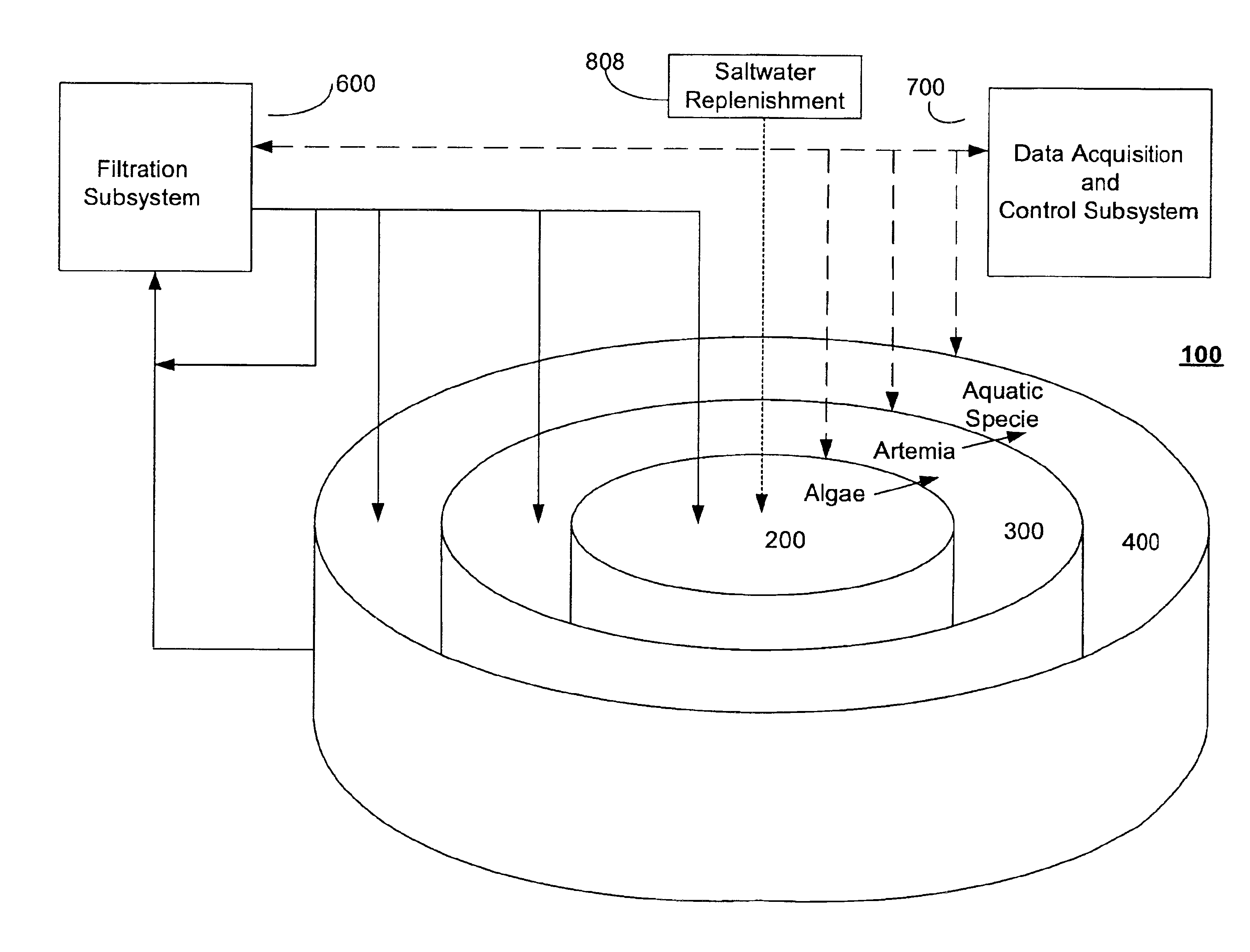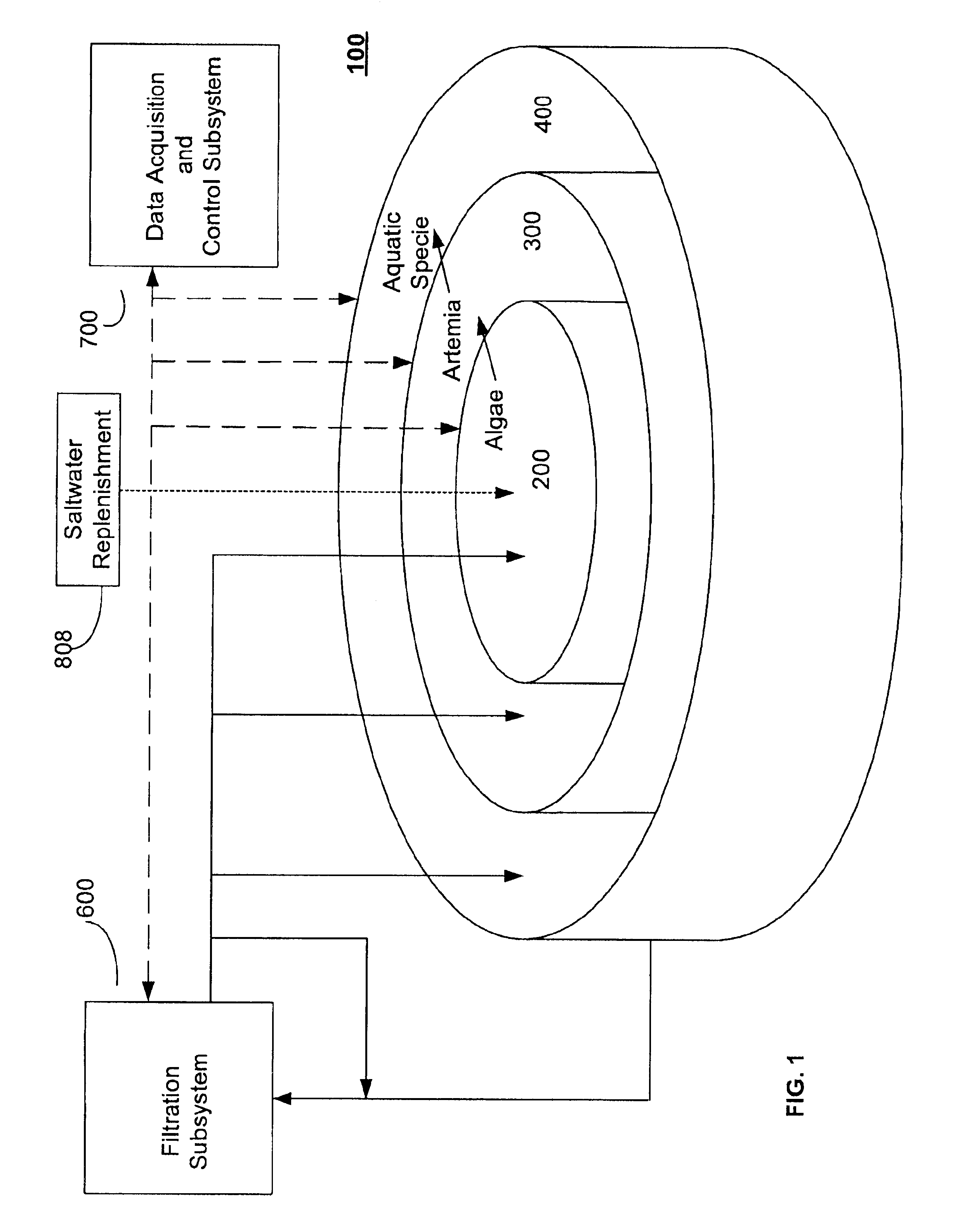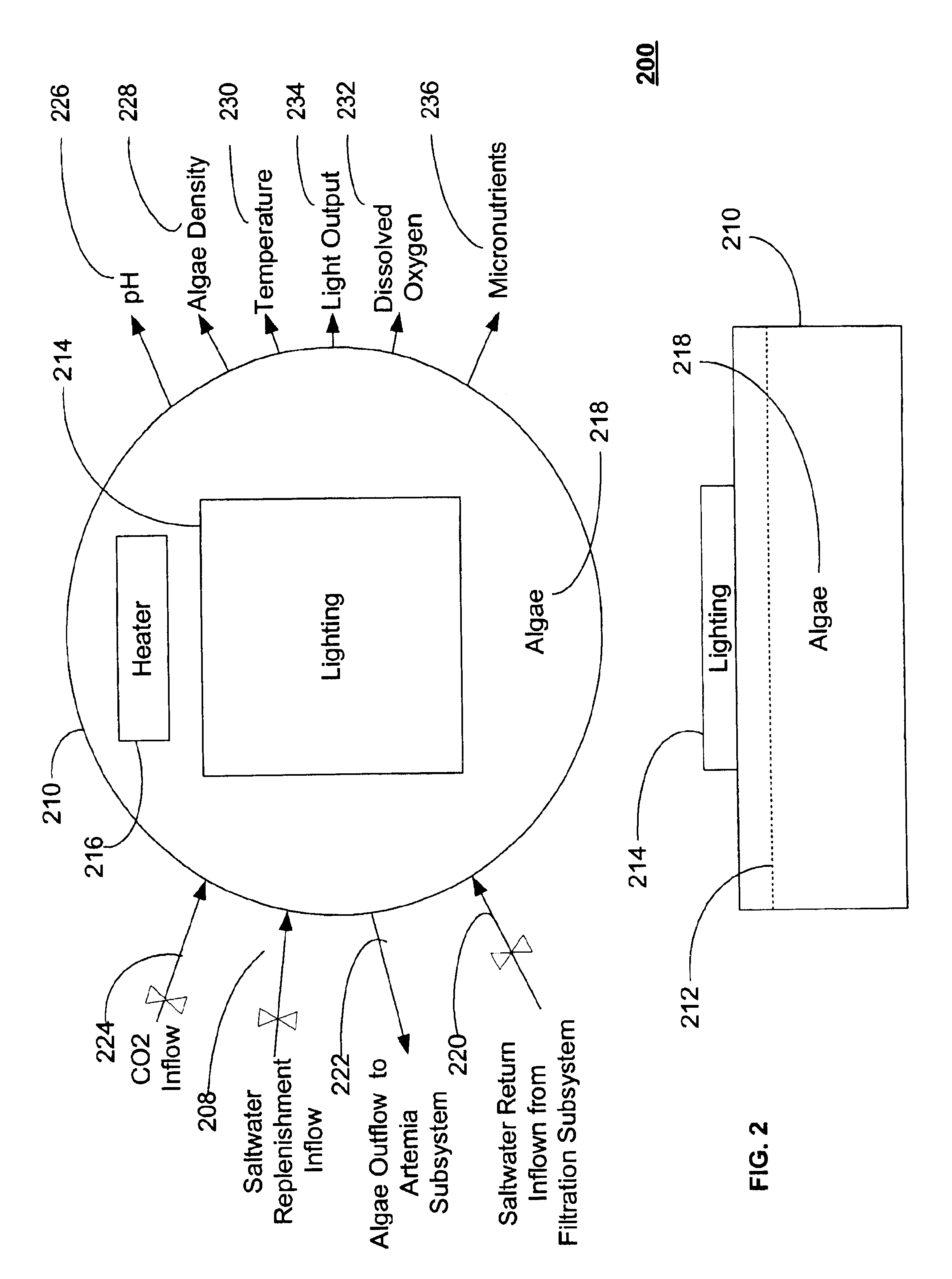The present invention provides a closed aquaculture system and method for producing aquatic specie and other
aquatic species that is not limited by the seasons of the year, is not limited by a declining catch rate, does not exhibit environmental concerns and is not affected by predators, weather, or diseases. The present invention provides high production rates, does not exhibit
water treatment or manufactured feed problems, and is not limited to a specific location for access to a shipping facility or proximity to the ocean. Use of
automation results in reduced labor costs and greater system density.
Unlike existing systems and methods, the present invention replicates a natural biological cycle by combining live algae, live artemia and live aquatic specie in a controlled environment. This combination of algae, artemia and aquatic specie stabilizes key
system parameters. In addition, the system can achieve higher algae, artemia and aquatic specie density than existing systems by using
automation to continually monitor and modify the saltwater environment.
The step of consuming the algae and the small artemia by the adolescent aquatic specie contained within the aquatic specie growout subsystem may further comprise containing the immature aquatic specie in one or more containers in the aquatic specie growout subsystem for consuming algae and artemia, illuminating the aquatic specie growout subsystem with a
light source for proper
algae growth, maintaining a temperature of the adolescent aquatic specie, algae, artemia and saltwater by a heater means, measuring waste, algae density, artemia density, aquatic specie size, aquatic specie density, temperature, pH,
ammonia,
light source output, and dissolved
oxygen, controlling
oxygen inflow,
light source output, saltwater return inflow from a
filtration subsystem, saltwater replenishment inflow, artemia inflow from the artemia subsystem, algae inflow from the algae subsystem and waste outflow to the
filtration subsystem, and gradually increasing the saltwater level in the one or more containers for increasing a volume of the one or more containers as the adolescent aquatic specie increase from adolescent size to adult size. The step of controlling the waste outflow to the filtration subsystem may comprise filtering the waste outflow from the aquatic specie growout subsystem through a filter screen to prevent immature aquatic specie from leaving the aquatic specie growout subsystem and allowing waste products to pass to the filtration subsystem. The filter screen may comprise a 2000 micron bottom section and a 5000 micron top section for enabling disposal of increased waste products from increasing size aquatic specie as the
effective volume of the aquatic subsystem is increased by adding increasing a saltwater level to accommodate the larger specie size. The controlling a saltwater return inflow value may maintain a waste outflow value to the filtration subsystem by controlling volume to adequately remove waste from the aquatic specie growout subsystem. The optimum waste
outflow rate from the aquatic specie growout subsystem may be selected to remove waste products from an aquatic specie density of from 0.25 to 0.5 pounds per gallon of saltwater. The one or more containers may be selected from the group consisting of open containers and sealed containers.
Another embodiment of the present invention is a method for producing adult aquatic specie in an aquaculture system, comprising growing algae in saltwater, feeding the algae to artemia in saltwater, producing artemia by the artemia in saltwater, feeding the algae and the artemia to an immature aquatic specie in saltwater to produce adult aquatic specie, and harvesting the adult aquatic specie from the saltwater when mature. The step of growing algae may comprise illuminating the algae in the saltwater by a light source, controlling a temperature of the algae in the saltwater by a heat source, regulating a CO2 inflow to control pH of the saltwater, replenishing saltwater lost due to
evaporation and leakage, regulating a saltwater return inflow for controlling algae outflow, and measuring pH, algae density, temperature, light source output, dissolved
oxygen and micronutrients. The step of feeding the algae to artemia in saltwater may comprise providing an inflow of algae and saltwater into the artemia in saltwater, illuminating the algae in the saltwater by a light source, controlling a temperature of the algae and artemia in saltwater by a heat source, regulating a CO2 inflow to control pH of the saltwater, regulating an oxygen inflow to control dissolved oxygen, regulating a saltwater return inflow for controlling artemia, algae, waste and saltwater outflow, and measuring pH, algae density, temperature, light source output,
ammonia, dissolved oxygen, waste, and artemia density. The step of producing artemia by the artemia in saltwater may comprise consuming algae by the adult artemia to generate small artemia, filtering the algae, adult artemia, small artemia, waste and saltwater through a screen that allows the algae, small artemia, waste and saltwater to pass as an outflow while restraining the adult artemia. The step of feeding the algae and the artemia to an immature aquatic specie in saltwater to produce adult aquatic specie may comprise providing an inflow of algae, artemia, waste and saltwater to the immature aquatic specie in saltwater, illuminating the algae in the saltwater by a light source, controlling a temperature of the algae, artemia, waste and saltwater by a heat source, regulating a CO2 inflow to control pH of the saltwater, regulating an oxygen inflow to control dissolved oxygen, regulating a saltwater return inflow for controlling artemia, algae, waste and saltwater outflow, measuring aquatic specie density, aquatic specie size, pH, algae density, temperature, light source output,
ammonia, dissolved oxygen, waste, volume and artemia density, consuming artemia by the immature aquatic specie to produce adolescent aquatic specie, consuming artemia by the adolescent aquatic specie to produce adult aquatic specie, and filtering the algae, aquatic specie, artemia, waste and saltwater through a graded screen that allows the algae, small artemia, waste and saltwater to pass as an outflow to a filtration means while restraining the aquatic specie. The method may further comprise positioning
habitat structures for increasing the number of aquatic specie in the subsystem.
 Login to View More
Login to View More  Login to View More
Login to View More 


